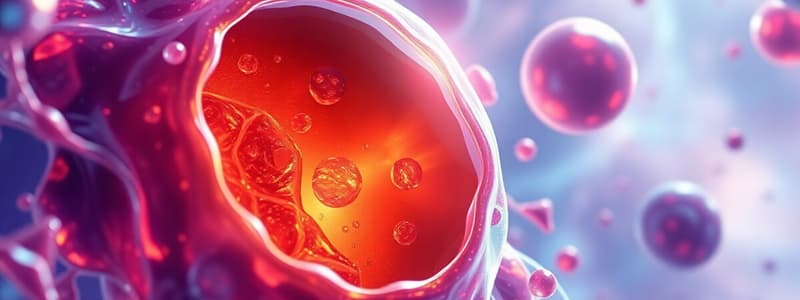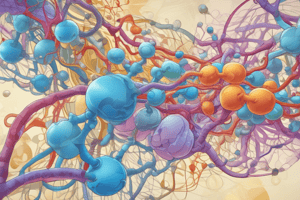Podcast
Questions and Answers
What is the primary function of the endoplasmic reticulum?
What is the primary function of the endoplasmic reticulum?
- Transport of nutrients
- Protein synthesis (correct)
- Storage of molecules
- DNA replication
What does the nuclear membrane primarily do?
What does the nuclear membrane primarily do?
- Stores genetic information
- Facilitates muscle contraction
- Produces ribosomes
- Surrounds and protects the nucleus (correct)
Which of the following is NOT a component of the nucleus?
Which of the following is NOT a component of the nucleus?
- Nucleoplasm
- Chromatin
- Ribosomes (correct)
- Nucleolus
What is a key feature of nuclear pores?
What is a key feature of nuclear pores?
Which organelle is responsible for molecule export?
Which organelle is responsible for molecule export?
Nucleoplasm is most similar to which part of the cell?
Nucleoplasm is most similar to which part of the cell?
What is the primary composition of the nucleolus?
What is the primary composition of the nucleolus?
What is chromatin primarily composed of?
What is chromatin primarily composed of?
What is the primary function of RNA polymerases in the nucleus?
What is the primary function of RNA polymerases in the nucleus?
What do transcription factors primarily do in the process of transcription?
What do transcription factors primarily do in the process of transcription?
Which process requires energy for the transport of macromolecules like RNA and proteins?
Which process requires energy for the transport of macromolecules like RNA and proteins?
What essential role do topoisomerases play during transcription?
What essential role do topoisomerases play during transcription?
How do small molecules behave when entering the nucleus?
How do small molecules behave when entering the nucleus?
What happens to the nucleus during the process of cell division?
What happens to the nucleus during the process of cell division?
What is NOT a function of the proteins found in the nucleus?
What is NOT a function of the proteins found in the nucleus?
Which statement about nuclear transport is false?
Which statement about nuclear transport is false?
What is the primary technique used to study cells?
What is the primary technique used to study cells?
Which process is NOT part of cell fractionation?
Which process is NOT part of cell fractionation?
How are different organelles separated during differential centrifugation?
How are different organelles separated during differential centrifugation?
What is the composition of the cell membrane?
What is the composition of the cell membrane?
What is a primary result of using microscopy in cell fractionation?
What is a primary result of using microscopy in cell fractionation?
Which organelles are specifically mentioned as being identified through biochemical methods?
Which organelles are specifically mentioned as being identified through biochemical methods?
What type of cell is primarily being referred to in the study of organelles?
What type of cell is primarily being referred to in the study of organelles?
What does the term 'homogenate' refer to in cell fractionation?
What does the term 'homogenate' refer to in cell fractionation?
What are ribosomes primarily made of?
What are ribosomes primarily made of?
What type of ribosomes are found in prokaryotes?
What type of ribosomes are found in prokaryotes?
Where are bound ribosomes located?
Where are bound ribosomes located?
Which structure is essential for the production of energy in a cell?
Which structure is essential for the production of energy in a cell?
What is a common disorder related to ribosome function?
What is a common disorder related to ribosome function?
What component of the mitochondrion is responsible for producing the majority of ATP during cellular respiration?
What component of the mitochondrion is responsible for producing the majority of ATP during cellular respiration?
Which ribosomal subunits are found in eukaryotes?
Which ribosomal subunits are found in eukaryotes?
What part of the mitochondrion is known to contain its DNA?
What part of the mitochondrion is known to contain its DNA?
What is the main role of the Golgi apparatus in relation to proteins?
What is the main role of the Golgi apparatus in relation to proteins?
Which of the following is NOT a defect associated with issues in Golgi function?
Which of the following is NOT a defect associated with issues in Golgi function?
What do vesicles produced by the Golgi apparatus primarily transport?
What do vesicles produced by the Golgi apparatus primarily transport?
How do products modify as they pass through the Golgi apparatus?
How do products modify as they pass through the Golgi apparatus?
What type of disorders can result from mistakes made by the Golgi apparatus?
What type of disorders can result from mistakes made by the Golgi apparatus?
What is the function of vacuoles as mentioned in the content?
What is the function of vacuoles as mentioned in the content?
Which of the following is an example of a substance transported by vesicles from the Golgi apparatus?
Which of the following is an example of a substance transported by vesicles from the Golgi apparatus?
What could be a potential consequence if the Golgi apparatus incorrectly ships proteins?
What could be a potential consequence if the Golgi apparatus incorrectly ships proteins?
Flashcards are hidden until you start studying
Study Notes
Studying Cells
- Biochemistry techniques are used to study cells
- Cell fractionation separates cell components based on size and density
- Homogenization - Process of breaking open cells
- Ultracentrifugation - Separates organelles based on density
Cell Fractionation
- Larger organelles separate first during centrifugation
- Organelles are identified using microscopy
- Biochemical methods determine the functions of organelles
Cell Membrane
- Also known as the plasma membrane
- Composed of two layers of phospholipids
- Endoplasmic reticulum and Golgi apparatus are connected through the endomembrane system
The Nucleus
- The largest cellular organelle in animals
- Components of the nucleus include:
- Nuclear membrane
- Nucleoplasm
- Nucleolus
- Chromatin and chromosomes
Nuclear Membrane
- Consists of a double membrane layer and contains nuclear pores
- Provides structural support and protection for the nucleus
- Enables the movement of molecules between the nucleus and cytoplasm
Nucleoplasm
- Liquid found inside the nucleus
- Contains DNA, RNA, and other cellular materials
- Similar to the cytosol within the cytoplasm
Nucleolus
- Sub-organelle of the cell nucleus
- Composed of rRNA and proteins
- Site of ribosome synthesis
Chromatin
- Composed of DNA and proteins
- Found inside the nucleus of eukaryotic cells
- Condensed to form chromosomes during cell division
Nuclear Transport
- Small molecules can enter the nucleus passively, without energy
- Macromolecules like RNA and proteins require active transport across the nuclear membrane
- This process is regulated by nuclear pore complexes
Assembly and Disassembly of the Nucleus
- During cell division, the nucleus breaks down
- Nucleus reforms during the final stages of cell division
The Golgi Apparatus
- Important role in protein synthesis
- Modifies and packages proteins
- Defects in Golgi function can cause disorders like congenital glycosylation disorders, muscular dystrophy, diabetes, cancer, and cystic fibrosis
Ribosomes
- Consist of a large subunit and a small subunit
- Found in both prokaryotic and eukaryotic cells
- Prokaryotic ribosomes are smaller (70S)
- Eukaryotic ribosomes are larger (80S)
- Synthesize proteins for use within the cell and for export
Ribosome Types
- Free ribosomes are suspended in the cytoplasm
- Involved in making proteins that function within the cytoplasm
- Bound ribosomes are attached to the endoplasmic reticulum
- Involved in making proteins destined for export or packaging within organelles
Disorders of Ribosomes
- Defects in ribosome function can cause various disorders:
- Anemia
- Cartilage hair hypoplasia
- Shwachman-Diamond Syndrome
- Dyskeratosis congenita
Mitochondria
- Powerhouse of the cell responsible for energy production
- Consists of:
- Outer membrane
- Inner membrane
- Matrix
- Cristae
- Intermembrane space
- Mitochondria contain their own DNA and ribosomes, allowing them to self-replicate
Biomedical Importance of Mitochondria
- Mitochondria are essential for cellular respiration, which produces energy for the cell
Studying That Suits You
Use AI to generate personalized quizzes and flashcards to suit your learning preferences.


